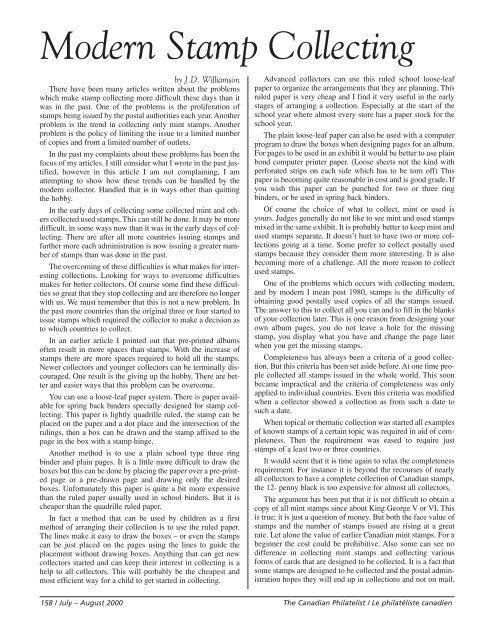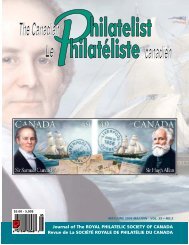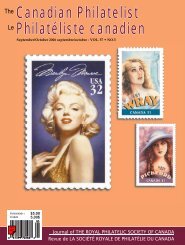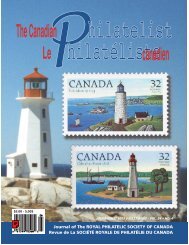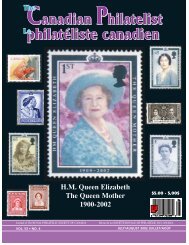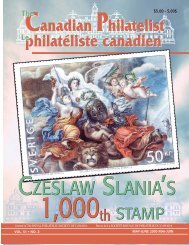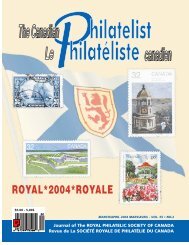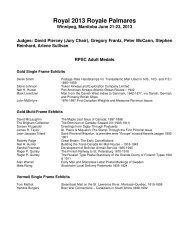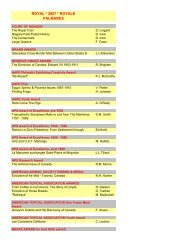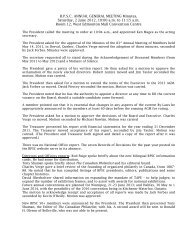Phil pages July-Aug-Final - The Royal Philatelic Society of Canada
Phil pages July-Aug-Final - The Royal Philatelic Society of Canada
Phil pages July-Aug-Final - The Royal Philatelic Society of Canada
Create successful ePaper yourself
Turn your PDF publications into a flip-book with our unique Google optimized e-Paper software.
Modern Stamp Collecting<br />
by J.D. Williamson<br />
<strong>The</strong>re have been many articles written about the problems<br />
which make stamp collecting more difficult these days than it<br />
was in the past. One <strong>of</strong> the problems is the proliferation <strong>of</strong><br />
stamps being issued by the postal authorities each year. Another<br />
problem is the trend in collecting only mint stamps. Another<br />
problem is the policy <strong>of</strong> limiting the issue to a limited number<br />
<strong>of</strong> copies and from a limited number <strong>of</strong> outlets.<br />
In the past my complaints about these problems has been the<br />
focus <strong>of</strong> my articles. I still consider what I wrote in the past justified,<br />
however in this article I am not complaining, I am<br />
attempting to show how these trends can be handled by the<br />
modern collector. Handled that is in ways other than quitting<br />
the hobby.<br />
In the early days <strong>of</strong> collecting some collected mint and others<br />
collected used stamps. This can still be done. It may be more<br />
difficult, in some ways now than it was in the early days <strong>of</strong> collecting.<br />
<strong>The</strong>re are after all more countries issuing stamps and<br />
further more each administration is now issuing a greater number<br />
<strong>of</strong> stamps than was done in the past.<br />
<strong>The</strong> overcoming <strong>of</strong> these difficulties is what makes for interesting<br />
collections. Looking for ways to overcome difficulties<br />
makes for better collectors. Of course some find these difficulties<br />
so great that they stop collecting and are therefore no longer<br />
with us. We must remember that this is not a new problem. In<br />
the past more countries than the original three or four started to<br />
issue stamps which required the collector to make a decision as<br />
to which countries to collect.<br />
In an earlier article I pointed out that pre-printed albums<br />
<strong>of</strong>ten result in more spaces than stamps. With the increase <strong>of</strong><br />
stamps there are more spaces required to hold all the stamps.<br />
Newer collectors and younger collectors can be terminally discouraged.<br />
One result is the giving up the hobby. <strong>The</strong>re are better<br />
and easier ways that this problem can be overcome.<br />
You can use a loose-leaf paper system. <strong>The</strong>re is paper available<br />
for spring back binders specially designed for stamp collecting.<br />
This paper is lightly quadrille ruled, the stamp can be<br />
placed on the paper and a dot place and the intersection <strong>of</strong> the<br />
rulings, then a box can be drawn and the stamp affixed to the<br />
page in the box with a stamp hinge.<br />
Another method is to use a plain school type three ring<br />
binder and plain <strong>pages</strong>. It is a little more difficult to draw the<br />
boxes but this can be done by placing the paper over a pre-printed<br />
page or a pre-drawn page and drawing only the desired<br />
boxes. Unfortunately this paper is quite a bit more expensive<br />
than the ruled paper usually used in school binders. But it is<br />
cheaper than the quadrille ruled paper.<br />
In fact a method that can be used by children as a first<br />
method <strong>of</strong> arranging their collection is to use the ruled paper.<br />
<strong>The</strong> lines make it easy to draw the boxes – or even the stamps<br />
can be just placed on the <strong>pages</strong> using the lines to guide the<br />
placement without drawing boxes. Anything that can get new<br />
collectors started and can keep their interest in collecting is a<br />
help to all collectors. This will probably be the cheapest and<br />
most efficient way for a child to get started in collecting.<br />
Advanced collectors can use this ruled school loose-leaf<br />
paper to organize the arrangements that they are planning. This<br />
ruled paper is very cheap and I find it very useful in the early<br />
stages <strong>of</strong> arranging a collection. Especially at the start <strong>of</strong> the<br />
school year where almost every store has a paper stock for the<br />
school year.<br />
<strong>The</strong> plain loose-leaf paper can also be used with a computer<br />
program to draw the boxes when designing <strong>pages</strong> for an album.<br />
For <strong>pages</strong> to be used in an exhibit it would be better to use plain<br />
bond computer printer paper. (Loose sheets not the kind with<br />
perforated strips on each side which has to be torn <strong>of</strong>f) This<br />
paper is becoming quite reasonable in cost and is good grade. If<br />
you wish this paper can be punched for two or three ring<br />
binders, or be used in spring back binders.<br />
Of course the choice <strong>of</strong> what to collect, mint or used is<br />
yours. Judges generally do not like to see mint and used stamps<br />
mixed in the same exhibit. It is probably better to keep mint and<br />
used stamps separate. It doesn’t hurt to have two or more collections<br />
going at a time. Some prefer to collect postally used<br />
stamps because they consider them more interesting. It is also<br />
becoming more <strong>of</strong> a challenge. All the more reason to collect<br />
used stamps.<br />
One <strong>of</strong> the problems which occurs with collecting modern,<br />
and by modern I mean post 1980, stamps is the difficulty <strong>of</strong><br />
obtaining good postally used copies <strong>of</strong> all the stamps issued.<br />
<strong>The</strong> answer to this to collect all you can and to fill in the blanks<br />
<strong>of</strong> your collection later. This is one reason from designing your<br />
own album <strong>pages</strong>, you do not leave a hole for the missing<br />
stamp, you display what you have and change the page later<br />
when you get the missing stamps.<br />
Completeness has always been a criteria <strong>of</strong> a good collection.<br />
But this criteria has been set aside before. At one time people<br />
collected all stamps issued in the whole world. This soon<br />
became impractical and the criteria <strong>of</strong> completeness was only<br />
applied to individual countries. Even this criteria was modified<br />
when a collector showed a collection as from such a date to<br />
such a date.<br />
When topical or thematic collection was started all examples<br />
<strong>of</strong> known stamps <strong>of</strong> a certain topic was required in aid <strong>of</strong> completeness.<br />
<strong>The</strong>n the requirement was eased to require just<br />
stamps <strong>of</strong> a least two or three countries.<br />
It would seem that it is time again to relax the completeness<br />
requirement. For instance it is beyond the recourses <strong>of</strong> nearly<br />
all collectors to have a complete collection <strong>of</strong> Canadian stamps,<br />
the 12- penny black is too expensive for almost all collectors.<br />
<strong>The</strong> argument has been put that it is not difficult to obtain a<br />
copy <strong>of</strong> all mint stamps since about King George V or VI. This<br />
is true; it is just a question <strong>of</strong> money. But both the face value <strong>of</strong><br />
stamps and the number <strong>of</strong> stamps issued are rising at a great<br />
rate. Let alone the value <strong>of</strong> earlier Canadian mint stamps. For a<br />
beginner the cost could be prohibitive. Also some can see no<br />
difference in collecting mint stamps and collecting various<br />
forms <strong>of</strong> cards that are designed to be collected. It is a fact that<br />
some stamps are designed to be collected and the postal administration<br />
hopes they will end up in collections and not on mail.<br />
158 / <strong>July</strong> – <strong>Aug</strong>ust 2000 <strong>The</strong> Canadian <strong>Phil</strong>atelist / Le philatéliste canadien


